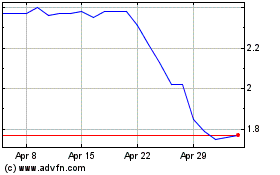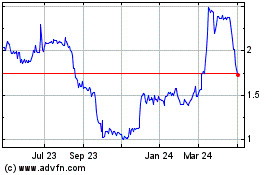Arch Biopartners Inc., (“Arch” or the “Company”) (TSX Venture: ARCH
and OTCQB: ACHFF), announced today that cilastatin, the Company’s
second drug candidate for preventing acute kidney injury (AKI),
will participate in the upcoming investigator led trial entitled
“
Prevention
Of
Nephro
Toxin
Induced
Acute kidney injury with
Cilastatin” (PONTIAC). PONTIAC is a 900 patient
Phase II trial that will evaluate the efficacy of the dipeptidase-1
inhibitor cilastatin for preventing AKI caused by drugs such as
antibiotics, chemotherapeutic agents and radiographic contrast.
The PONTIAC clinical team of investigators,
based out of the Universities of Calgary and Alberta, was awarded
$1,500,000 by the Canadian Institutes of Health Research (CIHR) to
fund the trial. The clinical team also received $400,000 as part of
the Accelerating Clinical Trials (ACT) call for proposals to
“Evaluate Canadian Biotechnologies with Randomized Controlled
Trials” (October 2023). Funds from both grants will be used by the
clinical team to conduct the PONTIAC trial.
The PONTIAC clinical team sponsoring the trial
is based in Calgary and is currently preparing to submit a Clinical
Trial Application (CTA) to Health Canada to proceed with the trial
by the fourth quarter of 2024. Arch is acting as a study partner
for grant funding opportunities, providing cilastatin drug product
and providing scientific and regulatory advice.
Cilastatin is an enzymatic dipeptidase-1 (DPEP1)
inhibitor approved by the FDA in 1985 for use as fixed combination
with imipenem to treat different types of bacterial infections.
Arch has method-of-use patents for repurposing cilastatin as a
treatment for acute kidney injury (AKI) in several jurisdictions,
including North America and Europe. There is no commercial history
of cilastatin as a stand-alone drug product.
The drug has a slightly different mechanism of
action compared with Arch’s novel drug candidate, LSALT peptide
(Metablok) a non-enzymatic DPEP1 inhibitor. Whereas LSALT peptide
specifically blocks DPEP1-mediated inflammation in the kidney,
lungs and liver, cilastatin has off target-effects that prevent
toxin uptake in the kidneys. As such, cilastatin is particularly
effective for toxin-related AKI.
The PONTIAC trial builds on research published
by lead Arch scientists and their colleagues in JCI (The
Journal of Clinical Investigation) in 2018, when cilastatin
was shown in pre-clinical models to effectively inhibit leukocyte
recruitment and drug toxin uptake in the kidney,
thereby preventing AKI caused by radiographic contrast.
Today’s announcement provides Arch’s drug
development program with a second target indication to prevent
acute injury to the kidneys. The Company is currently dosing
patients with its lead drug candidate, LSALT peptide, in an
ongoing, international Phase II study targeting cardiac
surgery-associated AKI (CS-AKI).
Quote from Mr. Richard Muruve, CEO Arch
Biopartners:
“We are excited to be the industry partner of
the PONTIAC trial while we continue to sponsor the Phase II trial
for LSALT peptide targeting CS-AKI. The PONTIAC and CS-AKI trials
combined are targeting about half of all AKI cases occurring in
hospitals today. We are very driven to complete these trials and
improve global kidney care with the first ever therapeutics to
prevent acute kidney injury.”
About AKI
AKI reflects a broad spectrum of clinical
presentations ranging from mild injury to severe injury that may
result in permanent and complete loss of renal function.
Clinically, the causes of AKI include sepsis, ischemia-reperfusion
injury, and various endogenous as well as exogenous (drug) toxins.
There is no specific therapeutic treatment available in the market
today that prevents AKI. In the worst cases, the kidneys fail,
requiring dialysis or kidney transplantation for patient
survival.
Drug toxins cause approximately 30% of AKI cases
in hospitalized patients and include a wide range of pharmaceutical
drugs such as antibiotics (vancomycin, aminoglycosides),
chemotherapeutic agents and radiographic contrast. Additionally,
AKI related to cardiac surgery (CS-AKI) accounts for up to 20% of
in-hospital AKI cases.
About Cilastatin
Cilastatin was originally developed in the early
1980s by Merck Sharp & Dohme Research Laboratories to limit
DPEP1’s role in the breakdown of imipenem, a β-lactam antibiotic
used for the treatment of systemic infections. Cilastatin was
approved for use as fixed combination with imipenem to treat
different types of bacterial infections. This fixed combination,
approved by the FDA in 1985, is currently marketed under different
names, including Primaxin® (USA, UK, Australia, Italy), Tienam®
(Spain, Belgium) or Zienam® (Germany). Patents for imipenem and
cilastatin have expired and the combination drug is currently in a
generic phase. There is no commercial history of cilastatin as a
stand-alone drug product.
About Arch Biopartners
Arch Biopartners Inc. is a late-stage clinical
trial company focused on preventing acute kidney injury. The
Company is developing a platform of new drugs to prevent
inflammation injury in the kidneys, lungs and liver via the
dipeptidase-1 (DPEP1) pathway and are relevant for many common
injuries and diseases where organ inflammation is an unmet
problem.
For more information on Arch Biopartners’
science and drug platform, please visit:
www.archbiopartners.com/our-science
For investor information and other public
documents the company has also filed on SEDAR+, please visit
www.archbiopartners.com/investor-hub
The Company has 64,650,633 common shares
outstanding.
Forward-Looking Statements
This press release contains forward-looking
statements within the meaning of applicable Canadian securities
laws regarding expectations of our future performance, liquidity
and capital resources, as well as the ongoing clinical development
of our drug candidates targeting the dipeptidase-1 (DPEP1) pathway,
including the outcome of our clinical trials relating to LSALT
peptide (Metablok) or cilastatin, the successful commercialization
and marketing of our drug candidates, whether we will receive, and
the timing and costs of obtaining, regulatory approvals in Canada,
the United States, Europe and other countries, our ability to raise
capital to fund our business plans, the efficacy of our drug
candidates compared to the drug candidates developed by our
competitors, our ability to retain and attract key management
personnel, and the breadth of, and our ability to protect, our
intellectual property portfolio. These statements are based on
management’s current expectations and beliefs, including certain
factors and assumptions, as described in our most recent annual
audited financial statements and related management discussion and
analysis under the heading “Business Risks and Uncertainties”. As a
result of these risks and uncertainties, or other unknown risks and
uncertainties, our actual results may differ materially from those
contained in any forward-looking statements. The words “believe”,
“may”, “plan”, “will”, “estimate”, “continue”, “anticipate”,
“intend”, “expect” and similar expressions are intended to identify
forward-looking statements, although not all forward-looking
statements contain these identifying words. We undertake no
obligation to update forward-looking statements, except as required
by law. Additional information relating to Arch Biopartners Inc.,
including our most recent annual audited financial statements, is
available by accessing the Canadian Securities Administrators’
System for Electronic Document Analysis and Retrieval (“SEDAR”)
website at www.sedarplus.ca.
The science and medical contents of this release
have been approved by the Company’s Chief Science Officer
Neither TSX Venture Exchange nor its Regulation
Services Provider (as that term is defined in the policies of the
TSX Venture Exchange) accepts responsibility for the adequacy or
accuracy of this release
For more information, please contact:
Richard Muruve
Chief Executive Officer
Arch Biopartners, Inc.
647-428-7031
info@archbiopartners.com
Arch Biopartners (TSXV:ARCH)
Historical Stock Chart
From Dec 2024 to Jan 2025

Arch Biopartners (TSXV:ARCH)
Historical Stock Chart
From Jan 2024 to Jan 2025
